
The Battle of Carillon, also known as the 1758 Battle of Ticonderoga, was fought on July 8, 1758, during the French and Indian War. It was fought near Fort Carillon on the shore of Lake Champlain in the frontier area between the British colony of New York and the French colony of New France.

Fort Carillon, presently known as Fort Ticonderoga, was constructed by Pierre de Rigaud de Vaudreuil, Governor of French Canada, to protect Lake Champlain from a British invasion. Situated on the lake some 15 miles (24 km) south of Fort Saint Frédéric, it was built to prevent an attack on Canada and slow the advance of the enemy long enough for reinforcements to arrive.
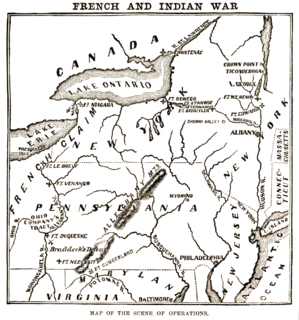
The 1759 Battle of Ticonderoga was a minor confrontation at Fort Carillon on July 26 and 27, 1759, during the French and Indian War. A British military force of more than 11,000 men under the command of General Sir Jeffery Amherst moved artillery to high ground overlooking the fort, which was defended by a garrison of 400 Frenchmen under the command of Brigadier General François-Charles de Bourlamaque.

Rogers' Rangers was a company of soldiers from the Province of New Hampshire raised by Major Robert Rogers and attached to the British Army during the Seven Years' War. The unit was quickly adopted into the British army as an independent ranger company. Robert Rogers trained and commanded the rapidly deployed light infantry force, which was tasked mainly with reconnaissance as well as conducting special operations against distant targets. Their tactics were built on earlier colonial precedents and were codified for the first time by Rogers as his 28 "Rules of Ranging". The tactics proved remarkably effective, so much so that the initial company was expanded into a ranging corps of more than a dozen companies. The ranger corps became the chief scouting arm of British Crown forces by the late 1750s. The British forces in America valued Rogers' Rangers for their ability to gather intelligence about the enemy. They were disbanded in 1761.
The 47th (Lancashire) Regiment of Foot was an infantry regiment of the British Army, raised in Scotland in 1741. It served in North America during the Seven Years' War and American Revolutionary War and also fought during the Napoleonic Wars and the Crimean War. Under the Childers Reforms it amalgamated with the 81st Regiment of Foot to form the Loyal Regiment in 1881.
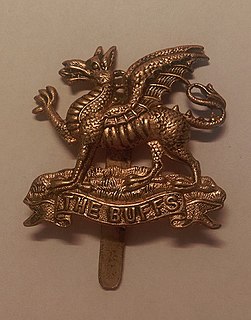
The Buffs , formerly the 3rd Regiment of Foot, was a line infantry regiment of the British Army traditionally raised in the English county of Kent and garrisoned at Canterbury. It had a history dating back to 1572 and was one of the oldest regiments in the British Army, being third in order of precedence. The regiment provided distinguished service over a period of almost four hundred years accumulating one hundred and sixteen battle honours. In 1881, under the Childers Reforms, it was known as the Buffs and later, on 3 June 1935, was renamed the Buffs .
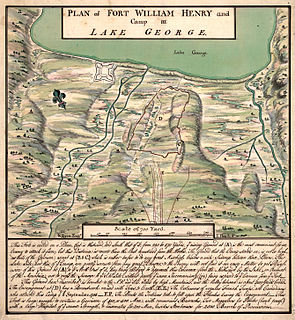
The siege of Fort William Henry was conducted by French General Louis-Joseph de Montcalm against the British-held Fort William Henry. The fort, located at the southern end of Lake George, on the frontier between the British Province of New York and the French Province of Canada, was garrisoned by a poorly supported force of British regulars and provincial militia led by Lieutenant Colonel George Monro. After several days of bombardment, Monro surrendered to Montcalm, whose force included nearly 2,000 Indians from various tribes. The terms of surrender included the withdrawal of the garrison to Fort Edward, with specific terms that the French military protect the British from the Indians as they withdrew from the area.
The New Hampshire Militia was first organized in 1631 and lasted until 1641, when the area came under the jurisdiction of Massachusetts. After New Hampshire became an separate colony again in 1679, New Hampshire Colonial Governor John Cutt reorganized the militia on March 16, 1680, with one foot company apiece for the four major settlements in Portsmouth, Dover, Exeter and Hampton, and an artillery and cavalry company in Portsmouth. The King of England authorized the Provincial Governor to give commissions to persons who shall be best qualified for regulating and discipline of the militia. President Cutt placed Major Richard Waldron of Dover in command of the Militia. In 1879, the Militia was designated by the state as the New Hampshire National Guard.
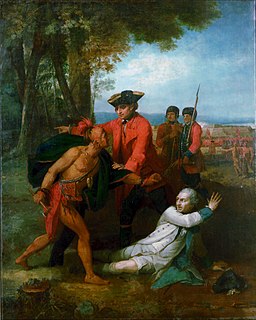
The Battle of Lake George was fought on 8 September 1755, in the north of the Province of New York. It was part of a campaign by the British to expel the French from North America, in the French and Indian War.

The 55th Regiment of Foot was a British Army infantry regiment, raised in 1755. After 1782 it had a county designation added, becoming known as the 55th (Westmorland) Regiment of Foot. Under the Childers Reforms it amalgamated with the 34th (Cumberland) Regiment of Foot to form the Border Regiment in 1881.
The 38th Regiment of Foot was an infantry regiment of the British Army, raised in 1705. Under the Childers Reforms it amalgamated with the 80th Regiment of Foot to form the South Staffordshire Regiment in 1881.
The 35th Regiment of Foot was an infantry regiment of the British Army, raised in 1701. Under the Childers Reforms it amalgamated with the 107th Regiment of Foot to form the Royal Sussex Regiment in 1881.

The Leicestershire Regiment was a line infantry regiment of the British Army, with a history going back to 1688. The regiment saw service for three centuries, in numerous wars and conflicts such as both World War I and World War II, before being amalgamated, in September 1964, with the 1st East Anglian Regiment, the 2nd East Anglian Regiment and the 3rd East Anglian Regiment to form the present day Royal Anglian Regiment, of which B Company of the 2nd Battalion continues the lineage of the Royal Leicestershire Regiment.
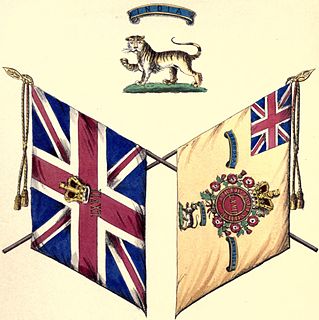
The 67th Regiment of Foot was a line infantry regiment of the British Army, raised in 1756. Under the Childers Reforms it amalgamated with the 37th Regiment of Foot to form the Hampshire Regiment in 1881.

The 40th Regiment of Foot was an infantry regiment of the British Army, raised in 1717 in Annapolis Royal, Nova Scotia. Under the Childers Reforms it amalgamated with the 82nd Regiment of Foot to form the Prince of Wales's Volunteers in 1881.
The 48th (Northamptonshire) Regiment of Foot was a regiment of the British Army, raised in 1741. Under the Childers Reforms it amalgamated with the 58th (Rutlandshire) Regiment of Foot to form the Northamptonshire Regiment in 1881.
The 58th (Rutlandshire) Regiment of Foot was a British Army line infantry regiment, raised in 1755. Under the Childers Reforms it amalgamated with the 48th (Northamptonshire) Regiment of Foot to form the Northamptonshire Regiment in 1881.
The 62nd (Wiltshire) Regiment of Foot was an infantry regiment of the British Army, which was raised in 1756 and saw service through the eighteenth and nineteenth centuries. Under the Childers Reforms it amalgamated with the 99th (Lanarkshire) Regiment of Foot to form the Wiltshire Regiment in 1881.

The siege of Louisbourg was a pivotal operation of the Seven Years' War in 1758 that ended the French colonial era in Atlantic Canada and led to the subsequent British campaign to capture Quebec in 1759 and the remainder of French North America the following year.

Provincial troops were raised by the colonial governors and legislatures for extended operations during the French and Indian Wars. The provincial troops differed from the militia, in that they were a full-time military organization conducting extended operations. They differed from the regular British Army in that they were recruited only for one campaign season at the time. These forces were often recruited through a quota system applied to the militia. Officers were appointed by the provincial governments. During the eighteenth century militia service was increasingly seen as a prerogative of the social and economic well-established, while provincial troops came to be recruited from different and less deep-rooted members of the community.











